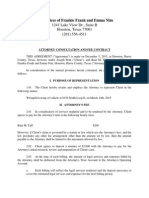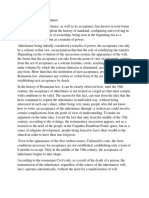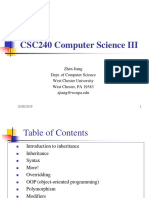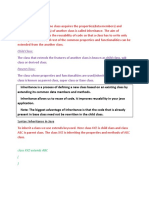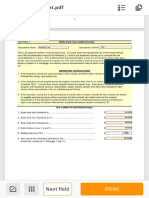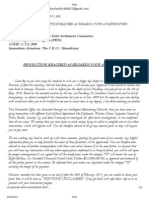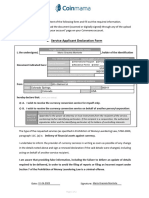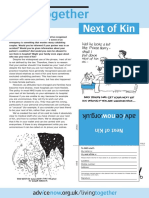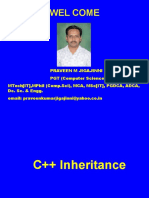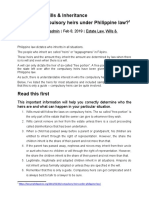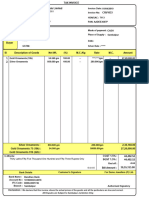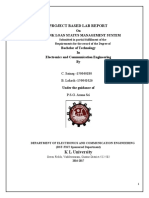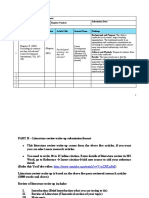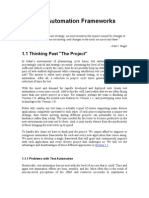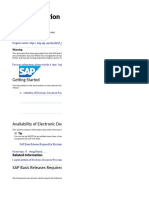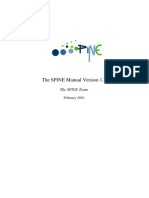SNS College of Technology: Object Oriented System Design
SNS College of Technology: Object Oriented System Design
Uploaded by
Jennifer CarpenterCopyright:
Available Formats
SNS College of Technology: Object Oriented System Design
SNS College of Technology: Object Oriented System Design
Uploaded by
Jennifer CarpenterOriginal Title
Copyright
Available Formats
Share this document
Did you find this document useful?
Is this content inappropriate?
Copyright:
Available Formats
SNS College of Technology: Object Oriented System Design
SNS College of Technology: Object Oriented System Design
Uploaded by
Jennifer CarpenterCopyright:
Available Formats
OBJECT ORIENTED SYSTEM DESIGN
SNS COLLEGE OF TECHNOLOGY
COIMBATORE 35
DEPARTMENT OF COMPUTER SCIENCE AND ENGINEERING (UG & PG)
Third Year Computer Science and Engineering, 6th Semester
2 Marks Question and Answer Subject Code & Name: OBJECT ORIENTED SYSTEM DESIGN Prepared by: T.Yaswini Jothi, Lecturer/CSE , B.Vinodhini, Lecturer/CSE UNIT I 1. Write about the traditional development methodologies? Most traditional development methodologies are either algorithm centric or data centric. a. Algorithm-centric methodology You think of an algorithm that can accomplish the task, and then build data structures for that algorithm to use. b. Data- centric methodology You think how to structure the data, and then build the algorithm around that structure. 2. Define objects. Object is a real- world entity, identifiably separate from its surroundings, has a well defined set of attributes and a well-defined set of procedures or methods. Properties (or attributes) describe the state (data) of an object. Methods (procedures) define its behavior. Object means a combination of data and logic that represents some real-world entity. (E.g.) Car is an object Color, manufacturer, cost, owner etc are attributes. Drive it, lock it, tow it, carry passengers in it are all methods. 3.Define Object Oriented Analysis? Object Oriented Analysis (OOA) is a method of analysis that examines requirements from the perspective of the classes and objects found in the vocabulary of the problem domain.
SNSCT Department of Compute Science and Engineering Page 1
OBJECT ORIENTED SYSTEM DESIGN
4.What is meant by Object Oriented? Object Oriented means we organize the software as a collection of discrete objects that incorporate both data structure and behavior. 5. Write the characteristics of an object. Identity, classification, polymorphism, and inheritance. 6.What is a class? A class is a set of objects that share a common structure and a common behavior. 7. Name two types of object diagram. Class diagram and instance diagram. 8. What is an attribute? Give example. An attribute is a data value held by the objects in a class .Example: name, age and weight are attributes of Person class. 9. Give a brief note on object behavior Object behavior is described in methods or procedures. Behavior denotes the collection of methods that abstractly describes what an object is capable of doing. Each procedure defines and describes a particular behavior of an object. Methods encapsulate the behavior of the object. Objects take responsibility for their own behavior. 10. What do you mean by information hiding? Information hiding is the principle of concealing the internal data and procedures of an object and providing an interface to each object and providing an interface to each object in such a way as to reveal as little as possible about its inner workings. An object is often said to encapsulate the date and a program. Per-class protection. o Class methods can access any object of that class and not just the receiver Per-object protection. o Methods can access only the receiver.
SNSCT Department of Compute Science and Engineering
Page 2
OBJECT ORIENTED SYSTEM DESIGN
11. Define class hierarchy Object oriented system organizes classes into a subclass-super class hierarchy. At the top of the class hierarchy are the most general classes and at the bottom are the more specific. A subclass inherits all of the properties and methods defined in its super class. Subclasses may refine or constrain the state and behavior inherited from its super class. A class may simultaneously be the subclass to some class and a super class to another class. Formal or abstract classes have no instances but define the common behaviors that con be inherited by more specific classes. 12. Write briefly about inheritance and explain the types of inheritance. Inheritance is the property of object-oriented systems that allows objects to be built from other objects. Inheritance is a relationship between classes where one class is the parent class of another derived class called base class or super class. Inheritance allows classes to share and reuse behaviors and attributes of all its super classes. Types of inheritance: Dynamic inheritance. It allows objects to change and evolve over time. Since base classes provide properties and attributes for objects, changing base classes changes the properties and attributes of a class. Multiple inheritance. Some object-oriented systems permit a class to inherit its state (attributes) and behaviors form more than one super class. 13. What do you mean by polymorphism? Polymorphism means that the same operation may behave differently on different classes. Polymorphism allows us to write generic, reusable code more easily, because we can specify general instructions and delegate the implementation details to the objects involved. 14. Explain object relationship and associations. a. Association represents the relationships between objects and classes. b. Associations are bidirectional.
SNSCT Department of Compute Science and Engineering
Page 3
OBJECT ORIENTED SYSTEM DESIGN
c. Cardinality specifies how many instances of one class may relate to a single instance of an associated class. d. Cardinality constraints the number of related objects and often is described as being one or many 15. What do you mean by consumer-producer association? It is also known as client-server association. It uses relationship. It is a oneway interaction in which one object requests the service of another object. The object that makes the request is the consumer or client and the object receives the request and provides the service is the producer or server. 16. Write about static and dynamic binding? o Static binding The process of determining which functions to invoke at compile time is termed as static binding. Static binding optimizes the calls. o Dynamic binding The process of determining which functions to invoke at runtime are called as dynamic binding. They occur when polymorphic calls are issued. Dynamic binding allows some method invocation decisions to be deferred until the information is known. 17.Define object persistence A file or a database can provide support for objects having a longer lifeline, longer than the duration of the process for which they were created. This is called object persistence. An object can persist beyond application session boundaries, during which the object is stored in a file or a database. The object can be retrieved in an other application session and will have same state and relationship. 18. Define meta-classes. If a class is an object, it must belong to a class which is called as meta-class or a class of classes. All the objects are instances of a class and all classes are instances of a meta-class. Meta-classes are used by the compiler. 19. What do you mean by software development process? The software development process consists of Analysis
SNSCT Department of Compute Science and Engineering Page 4
OBJECT ORIENTED SYSTEM DESIGN
Design Implementation Testing Refinement The essence of software development process is to transform users needs into a software solution that satisfies those needs. The main point is to build highquality software. 20.Define collaboration. The object-oriented programming community has adopted use-cases to a remarkable degree. Scenarios are a great way of examining who does what in the interactions among objects and what role they play; that is their interrelationships. This intersection among objects roles to achieve a given goal is called collaboration. 21. Write the 80-20 rule. a. Documentation is another important activity, which does not end with object-oriented analysis but should be carried out throughout the system development. b. The 80-20 rule generally applies for documentation: 80 percent of the work can be done with 20 percent of the documentation. 22. Define Prototype. Give the types of prototype. A prototype is a version of a software product developed in the early stages of the products life cycle for specific, experimental purposes. A prototype enables you to fully understand how easy or difficult it will be to implement some of the features of the system. It also gives users a chance to comment on the usability and usefulness of the user interface design. Prototypes have been categorized in various ways. Horizontal prototype Vertical prototype Analysis prototype Domain prototype 23. Write a brief note on RAD. a. Rapid application development (RAD) is a set of tools and techniques that can be used to build an application faster than typically possible with traditional methods.
SNSCT Department of Compute Science and Engineering
Page 5
OBJECT ORIENTED SYSTEM DESIGN
b. The developer sacrifices the quality of the product for the quicker delivery. c. RAD does not replace the system development life cycle but complements it, since it focuses more on process description and can be combined perfectly with the object-oriented approach. d. The main objective of RAD is to build a version of an application rapidly to see whether the system does what it is supposed to do. e. RAD involves a number of iterations. RAD encourages the incremental development approach. 24. Write about CBD? Component based development is an industrialized approach to the software development process. Application development moves from custom development to assembly of prebuilt, pretested, reusable software components that operate with each other. 25. Why do we go for object oriented systems development? The motivation factor behind object-oriented system development is the desire to make software development easier and more natural by raising the level of abstraction to the point where the level of abstraction to the point where applications can be implemented in the same terms n which they are described by users. 26. What is horizontal prototype? It is a simulation of the interface ie, it has the entire user interface that will be in the fullfeatured system but contains no functionality. 27. Explain the domain prototype? It is an aid for the incremental developmental of the ultimate software solution. It often is used as a tool for the staged delivery of subsystems to the users or other members of the developmental team. 28. Write about the Vertical prototype? Its a subset of the system features with complete functionality. The principal advantage of this method is that the few implemented functionality can be tested in great depth. 29. Explain Analysis prototype? It is an aid for exploring the problem domain. This class of prototype is used to inform the user and demonstrate the proof of a concept. It is not used as the basis of development. The final product will use the concepts exposed by the prototype, not its code.
SNSCT Department of Compute Science and Engineering Page 6
OBJECT ORIENTED SYSTEM DESIGN
30.Write the four quality measures for software development? Correspondence, correctness, verification, and validation. 31.What is cardinality? Cardinality specifies how many instances of one class may relate to a single instance of an associated class. 32. What is a formal class or abstract class? Formal or abstract classes have no instances but define the common behaviors that can be inherited by more specific classes. 33. What is a meta-class? A meta-class is a class about a class. They are normally used to provide instance variables and operations. 34. Define Encapsulation? Encapsulation is the process of compartmentalizing the elements of an abstraction that constitute its structure and behavior. 35. What is the need of an Object diagram? An object diagram is used to show the existence of objects and their relationships in the logical design of a system. 36. What is state of an object? The state of an object encompasses all of the properties of the object plus the current values of each of these properties. 37. Write some applications of object model? They include Air traffic control, Animation, Avionics, Database, Robotics etc. 38. Define Concurrency. Concurrency is the property that distinguishes an active object from one that is not active. 39. Name the three general approaches for classification?
SNSCT Department of Compute Science and Engineering Page 7
OBJECT ORIENTED SYSTEM DESIGN
They are Classical categorization, Conceptual clustering and Prototype theory. 40. Name the five levels of process maturity in OOD? They are Initial, Repeatable, Defined, Managed and Optimized.
POSSIBLE BIG QUESTIONS 1. Explain Object Oriented Systems Development Methodology. Why there is a need for an Object Orientation? 2. Compare Structured Approach and Object Oriented Approach with an application. 3. Explain about Class Hierarchy and Polymorphism with detailed examples. 4. Explain the stages involved in the Object Oriented Systems Development Life Cycle. 5. Define an object. Explain: A) How objects are grouped into classes? B) Object State and Properties C) Object Behavior and Methods D) Object Respond to Messages. 6. Explain about basic class modeling.
SNSCT Department of Compute Science and Engineering
Page 8
OBJECT ORIENTED SYSTEM DESIGN
UNIT II 1. Write about the four phases in OMT? OMT consists of four phases. They are Analysis-The results are objects and dynamic & functional models. System design-The results are a structure of the basic architecture of the system along with high-level strategy decisions. Object Design-Produces a design document, consisting of detailed objects static, dynamic and functional models Implementation-This activity produces reusable, extendible, robust code. 2. What do you mean by object diagram? The object model of OMT is represented graphically with an object diagram. The object diagram contains classes interconnected by association lines. Each class represents a set of individual objects. The association lines establish relationships among the classes. Each association line represents a set of links from the objects o f one class to the objects of another class 3. What are the primary symbols used in Data Flow Diagrams? Data flow diagrams use four primary symbols: The process is any function being performed.(verify password in the ATM) The data flow shows the direction of data element movement.(PIN code) The data store is a location where data are stored.(Account in ATM) An external entity is a source or destination of a data element .(the ATM card reader)
SNSCT Department of Compute Science and Engineering
Page 9
OBJECT ORIENTED SYSTEM DESIGN
4. What are the diagrams used in Booch methodology? The Booch methodology consists of the following diagrams: _ Class diagrams. _ Object diagrams. _ State transition diagrams. _ Module diagrams. _ Process diagrams. _ Interaction diagrams. 5. Give the steps involved in Macro development process in Booch methodology. The macro development process consists of the following steps: o Conceptualization Establish the core requirements and develop a prototype. o Analysis and development of the model Use the class diagram to describe the roles and responsibilities of objects. Use the object diagram to describe the desired behavior of the system. o Design or create the system architecture. Use the class diagram to decide what classes exist and how they relate to each other, the object diagram to decide what mechanisms are used, the module diagram to map out where each class and object should be declared, and the process diagram to determine to which processor to allocate a process. o Evolution or implementationRefine the system through much iteration. o Maintenance-Make localized changes to the system to add new requirements and eliminate bugs.
6. Give the steps involved in Micro development process in Booch methodology.
SNSCT Department of Compute Science and Engineering Page 10
OBJECT ORIENTED SYSTEM DESIGN
The micro process is a description of the day-to-day activities by a single or small group of software developers. It consists of the following steps. o Identify classes and objects. o Identify class and object semantics. o Identify class and object relationships. o Identify class and object interface and implementation. 7. Write briefly about Use Cases. Use cases are scenarios for understanding system requirements. A use case is an interaction between users and a system. The use-case model captures the goal of the user and the responsibility of the system to its users. The use-case model employs extends and uses relationships. The use cases are described as one of the following: Nonformal text with no clear flow of events Text with a clear flow of events Formal style using pseudo code. 8.Write short note on Objectory. Object-oriented software engineering (OOSE), also called Objectory, is a method or object-oriented development with the specific aim to fit the development of large, real-time systems. Objectory, is a disciplined process for the industrialized development of software, based on a use-case driven design. Objectory is built around several different models: Use case-model. Domain object model. Analysis object model. Implementation model. Test model. 9. Define patterns.
SNSCT Department of Compute Science and Engineering
Page 11
OBJECT ORIENTED SYSTEM DESIGN
Design pattern identifies the key aspects of a common design structure that makes it useful for creating a reusable object-oriented design. Furthermore, it identifies the participating classes and instances, their roles and collaborations, and the distribution of responsibilities. It describes when it applies, whether it can be applied in view of other design constraints and the consequences and trade-offs of its use. A pattern is an instructive information that captures the essential structure and insight of a successful family of proven solutions to a recurring problem that arises within a certain context and system of forces. 10. Define proto-patterns. Even if something appears to have all the requisite pattern components, it should not be considered a pattern until it has been verified to be a recurring phenomenon (preferably found in at least three existing system; this often is called rule of three). A proto-pattern is the pattern in waiting which is not yet known to recur. It is the pattern waiting to undergo some degree of peer scrutiny or review. 11. Define patterns template. Give some examples for components in pattern. Every pattern must be expressed in the form of a rule which is called as a template. It should establish a relationship between a context, a system of forces which arises in the context, and a configuration. Some of the essential components are: Name Problem Context Forces Solution Examples 12. Define anti-patterns. An anti-pattern represents a worst practice while a pattern represents a best practice. Anti-patterns come in two varieties: Those describing a bad solution to a problem that resulted in a bad situation. Those describing how to get out of a bad situation
13. Define pattern mining. Give the steps involved in capturing pattern.
SNSCT Department of Compute Science and Engineering
Page 12
OBJECT ORIENTED SYSTEM DESIGN
The process of looking for patterns to document is called pattern mining sometimes called reverse architecturing. The steps involved are: Focus on practicability. o Patterns should describe proven solutions to problems rather than the latest scientific results. Aggressive disregard of originality. o Pattern writers do not need to be the original inventor of the soln. Non anonymous review. o Pattern submissions are shepherded rather than reviewed. Writers workshops instead of presentations. o Rather than being presented by the authors, the patterns are discussed in the writers workshops. Careful editing. o The pattern authors should have the opportunity to incorporate all the comments and insights during the shepherding. 14. Define frame work. Give the differences between design patterns and frameworks. A frame work is a way of presenting a generic solution to a problem that can be applied to all levels in a development. Frameworks are a way of delivering application development patterns. A framework provides architectural guidance, captures the design decisions that are common to its application domain and thus emphasize design reuse over code reuse. The major differences between design patterns and frameworks are as follows: A framework is executable software whereas design patterns represent knowledge and experience about the software. Design patterns are more abstract than frameworks. Design patterns are smaller architectural elements than frameworks. Design patterns are less specialized than frameworks.
15. Why do we go for unified approach?
SNSCT Department of Compute Science and Engineering
Page 13
OBJECT ORIENTED SYSTEM DESIGN
The main motivation for going to unified approach is to combine the best practices, processes, methodologies, and guidelines along with UML (Unified Modeling Language) notations and diagrams for better understanding objectoriented concepts and system development. 16. Write short note on UA proposed Repository. The repository allows the maximum reuse of previous experience and previously defined objects, patterns, frameworks, and user interfaces in an easily accessible manner with a completely available and easily utilized format. Everything from the user request to maintenance of the project should be kept in the repository. This will reduce the cost and development time. It should be relatively easy to search the repository. 17. Define model. Explain about the types of model. A model is an abstract representation of a system, constructed to understand the system prior to building or modifying it. It is a model of a simplified representation of reality. Models can represent static or dynamic situations. Static model o It can be viewed as a snapshot of a systems parameters at rest or a specific point in time. They are needed to represent the structural or static aspect of a system. The UML class diagram is an example of static model. Dynamic model o It can be viewed as a collection of procedures or behaviors that taken together reflect the behavior of a system over time. Dynamic modeling is the most useful during the design and implementation phases of the system development. The UML interaction diagrams and activity models are examples of dynamic models. 18. What are the advantages of Modeling? Good models are essential for communication among project teams. As the complexity of systems increases, so does the importance of good modeling techniques. Some of the advantages are as follows: Models make it easier to express complex ideas. The main reason for modeling is to reduction of complexity. Models enhance and reinforce learning and training. The cost of modeling analysis is much lower than the cost of similar perimentation conducted in real system. Manipulation of the model is much easier.
Page 14
SNSCT Department of Compute Science and Engineering
OBJECT ORIENTED SYSTEM DESIGN
19. Define UML. Mention the primary goals in the design of the UML. The unified modeling language (UML) is a language for specifying, constructing, visualizing and documenting the software system and its components. The UML is a graphical language with sets of rules and semantics. The primary goals in the design of the UML were as follows: Provide users a ready-to-use, expressive visual modeling language so they can develop and exchange meaningful models Provide extensibility and specialization mechanisms to extend the core concepts. Be independent of particular programming languages and development processes. Provide a formal basis for understanding the modeling language. Encourage the growth of the OO tools market. Support higher-level development concepts. Integrate best practices and methodologies. 20. Give the nine UML graphical diagrams. a. Class diagram(static) b. Use-case diagram c. Behavior diagram(dynamic) i. Interaction diagram 1. Sequence diagram 2. Collaboration diagram ii. State chart diagram iii. Activity diagram d. Implementation diagram. i. Component diagram ii. Deployment diagram. 21. What is a Package? A package groups and manages the modeling elements, such as classes, their associations, and their structures. Packages themselves may be nested within other packages. 22. What is an association? Give one example.
SNSCT Department of Compute Science and Engineering
Page 15
OBJECT ORIENTED SYSTEM DESIGN
An association is the relationship between the classes. Ex person and company are the classes, works-for is the association name.
23. What is a qualifier? Give one example. A qualifier is an association attribute. The qualifier rectangle is part of the association path, not part of the class.
24.What is a method? A method is the implementation of an operation for a class. 25. What is a use case? Use cases are scenarios for understanding system requirements. A use case is an interaction between users and a system. 26. Name the three types of relationships in a use case diagram. Communication, Uses, extends. 27. Write the two types of Implementation diagram? Component diagram, deployment diagram. 28. What is an activity? An activity is a set of operations that is executing during the entire period an object is in a state. 29. Write the guidelines for preparing the Documentation. Common cover, 80-20 rule, Familiar vocabulary, make the document as short as possible, organize the document. 30. Name the types of relationships among the objects. Association, super-sub structure, aggregation.
SNSCT Department of Compute Science and Engineering Page 16
OBJECT ORIENTED SYSTEM DESIGN
31. Write the guidelines for identifying the associations A dependency between two or more classes may be association A reference from one class to another is an association. 32. Name the two properties of a part of relationship. Transitivity, Anti symmetry. 33. Write the Guidelines for identifying part of relationship. Assembly, container, collection member
POSSIBLE BIG QUESTIONS 1. Explain about the UML class diagrams in detail with suitable examples. 2. Explain about the UML state modeling in detail with suitable examples. 3. Explain about the UML interaction modeling in detail. 4. What is a Use-case? What are the techniques available in it? 5. Explain about Super-sub class relationships and A-part-of relationships in detail with suitable examples.
UNIT III
SNSCT Department of Compute Science and Engineering
Page 17
OBJECT ORIENTED SYSTEM DESIGN
1. What is the purpose of analysis? Why do we need analysis? The main objective of the analysis is to capture a complete, unambiguous,and consistent picture of the requirements of the system and what the system must do to satisfy the users requirements and needs. Object analysis is a process by which we can identify the classes that play a role in achieving the system goals and requirements. Hence, we are in need of analysis. 2.Why analysis is a difficult activity? Analysis is a creative activity that involves understanding the problem, its associated constraints, and methods of overcoming those constraints. The three most common sources of requirement difficulties are: Fuzzy descriptions: Fuzzy and ambiguous description leads to requirement ambiguity. Incomplete requirements: Certain requirements that are not included for variety of reasons might be necessary for successful system development. Unnecessary features: Every additional feature could affect the performance, complexity, stability, and support costs of an application. Analysis is a difficult activity because one has to understand the problem in some application domain and then has to define a solution that can be implemented with any software. 3. Write a short note on use-case model? A use-case model can be instrumental in project development, planning, and documentation of systems requirements. The use-case model describes the uses of the system and shows the courses of events that can be performed. It also defines what happens in the system when the use case is performed. It can also discover the classes and the relationships among subsystems of the system. 4.When extends association is used? The extends association is used when you have one use case that is similar to another use case but does a bit more or is more specialized. It is like a subclass. Extends association is utilized to expand the common behavior to fit the special circumstances. 5.Define uses association.
SNSCT Department of Compute Science and Engineering Page 18
OBJECT ORIENTED SYSTEM DESIGN
The uses association occurs when some of the use cases have subflows in common. Here to avoid describing a subflow more than once in several use cases, the common subflow can be extracted and made into a new use case of its own.The relationship among the other use cases and this new extracted use case is called a uses association. 6.Give the two-three rule? The two-three rule is for identifying actors. The rule is stated as start with naming at least two, preferable three, people who could serve as the actors in the system. Other actors can be identified in the subsequent iterations. 7. List the approaches for identifying classes? The four alternative approaches for identifying classes: The noun phrase approach. The common class patterns approach. The use-case driven, sequence/collaboration modeling approach. The classes, responsibilities and collaborators (CRC) approach. 8.What do you mean by relevant, fuzzy and irrelevant classes? In the noun phrase approach the list of nouns is divided into three categories: Relevant classes: Relevant classes have a purpose. They are clearly defined and so they are necessary. Fuzzy classes: Fuzzy classes are those classes which we are not sure about. Irrelevant classes: These classes have no purpose and are unnecessary. It is safe to scrap these irrelevant classes.
9.What are the three steps in CRC process? The classes, responsibilities and collaborators process consists of three steps: Identify classes responsibilities (and identify classes). Assign responsibilities. Identify collaborators.
SNSCT Department of Compute Science and Engineering
Page 19
OBJECT ORIENTED SYSTEM DESIGN
Identify classes & responsibility
Identify collaboration
Assign responsibility
10. How would you identify attributes? Attributes usually correspond to nouns followed by preposition phrases. Attributes also may correspond to adjectives or adverbs. Keep the class simple; state only enough attributes to define the object state. Attributes are less likely to be fully described in the problem statement. Omit derived attributes. They should be expressed as a method. Do not carry excess identification. 11.How would you identify methods? The sequence diagrams assist us in defining services that the objects must services are implemented as the methods for your objects. provide. These
In a sequence diagram the events that occur between objects are drawn between the vertical object lines. An event is considered to be an action that transmits information; therefore these actions are the operations that the objects must perform. Methods also can be derived from the scenario testing. 12. Write the syntax for presenting the attribute that was suggested by UML. visibility name : type_expression = initial _value Where visibility is one of the following + public visibility # protected visibility - private visibility type_expression - type of an attribute
SNSCT Department of Compute Science and Engineering Page 20
OBJECT ORIENTED SYSTEM DESIGN
Initial_value is a language dependent expression for the initial value of a newly created object. 13. Write the syntax for presenting the operation that was suggested by UML visibility name : (parameter_list): return _type_expression Where visibility is one of the following + public visibility # protected visibility - private visibility parameter- is a list of parameters. Return_type_expression: is a language _dependent specification of the Implementation of the value returned by the method. 14. Define OCL? The rules and semantics of the UML are expressed in English, in a form known as object constraint language. Object constraint language (OCL) is a specification language that uses simple logic for specifying the properties of a system. 15. What is CRC? Classes, responsibilities, and collaborators is a technique used for identifying classes responsibilities, and collaborators and therefore their attributes and methods. Furthermore, CRC can help us identify classes. CRC is based on the idea that an object either can accomplish a certain responsibility itself or it may require the assistance of other objects. CRC cards are 4``X 6`` index cards in which all the information for an object is written is cheap, portable, readily
Class Name
Responsibilities Collaborators
available and familiar.
SNSCT Department of Compute Science and Engineering
Page 21
OBJECT ORIENTED SYSTEM DESIGN
POSSIBLE BIG QUESTIONS 1. Explain about system conception. 2. Explain about domain analysis.
3. Explain about application analysis.
SNSCT Department of Compute Science and Engineering
Page 22
You might also like
- Iso 29481-1 - 2010Document42 pagesIso 29481-1 - 2010Diego VilchesNo ratings yet
- NIAGARA EC-Net AX STUDY BOOK AND PRACTICE PDFDocument470 pagesNIAGARA EC-Net AX STUDY BOOK AND PRACTICE PDFAbiodun Ilori50% (2)
- Attorney Fee Agreement For Hourly ClientsDocument5 pagesAttorney Fee Agreement For Hourly ClientsRianNo ratings yet
- Consignment Agreement - India PerspectiveDocument3 pagesConsignment Agreement - India PerspectiveHemant VermaNo ratings yet
- Change of OwnershipDocument3 pagesChange of Ownershipsatyajoshi100% (1)
- AMC - Next of Kin FormDocument1 pageAMC - Next of Kin FormJ.m. Jocson100% (3)
- Acceptance of The InheritanceDocument3 pagesAcceptance of The InheritanceEnasel Dragos100% (1)
- Law of Inheritance in Different ReligionsDocument35 pagesLaw of Inheritance in Different ReligionsSumbal83% (12)
- 11 InheritanceDocument26 pages11 InheritanceMallika RaghuvanshiNo ratings yet
- Emerge On T24Document10 pagesEmerge On T24wpedro2013No ratings yet
- QR Code BarcodeDocument23 pagesQR Code BarcodeKamen Rider100% (1)
- What Is Inheritance ?Document4 pagesWhat Is Inheritance ?ultrasamsNo ratings yet
- Women's InheritanceDocument5 pagesWomen's InheritanceMuneeza RafiqNo ratings yet
- CSC 240 InheritanceDocument81 pagesCSC 240 InheritanceSal ManNo ratings yet
- Inheritance With Spanish WillDocument5 pagesInheritance With Spanish WillStephen Mc GrathNo ratings yet
- 17 Friendship and InheritanceDocument9 pages17 Friendship and InheritanceDhirean Kumar SunarNo ratings yet
- UntitledDocument2 pagesUntitledMia MalkovaNo ratings yet
- Child Class:: The Class That Extends The Features of Another Class Is Known As Child Class, Sub Class or Derived ClassDocument4 pagesChild Class:: The Class That Extends The Features of Another Class Is Known As Child Class, Sub Class or Derived ClassQasim HassanNo ratings yet
- Introduction To The Oracle Academy: Section 1 DesignDocument10 pagesIntroduction To The Oracle Academy: Section 1 DesignrahmatNo ratings yet
- How To Make A Custom Cell Format: Try It HereDocument4 pagesHow To Make A Custom Cell Format: Try It HerekaviisNo ratings yet
- Certificate of Inheritance Usa - PRNTBL - Concejomunicipaldechinu.gov - Co 2Document1 pageCertificate of Inheritance Usa - PRNTBL - Concejomunicipaldechinu.gov - Co 2warnergrace577No ratings yet
- PDFfiller - Inheritance Format PDFDocument1 pagePDFfiller - Inheritance Format PDFademola100% (1)
- Gaddafi FormatDocument1 pageGaddafi FormatBalachandran Gopal100% (1)
- Consignment Account Doc 2Document13 pagesConsignment Account Doc 2subhankar fc100% (1)
- Real Trust FormatDocument1 pageReal Trust FormatOlalekan MuhammedNo ratings yet
- FRMTDocument4 pagesFRMTjeremillojoshuaNo ratings yet
- LetterDocument2 pagesLettermitzuyuta100% (3)
- 6 InheritanceDocument14 pages6 InheritancedeepakNo ratings yet
- DISTRIBUTION OF WEALTH AND InheritDocument18 pagesDISTRIBUTION OF WEALTH AND InheritAbdi Rabbihi100% (1)
- Inheritance Format - Fill Online, Printable, FillDocument1 pageInheritance Format - Fill Online, Printable, Filladekoyaademide78No ratings yet
- Scam Email From "The Federal Republic of Nigeria" Regarding Some Kind of Fund To Which I Am A BeneficiaryDocument2 pagesScam Email From "The Federal Republic of Nigeria" Regarding Some Kind of Fund To Which I Am A BeneficiaryAaron Monk100% (1)
- Celeb FormatDocument2 pagesCeleb FormatifeanyionumajuruNo ratings yet
- SSN-21 Seawolf - Quick Reference Card - PCDocument21 pagesSSN-21 Seawolf - Quick Reference Card - PCMarvin Mclendon100% (1)
- Project Approval FormatDocument10 pagesProject Approval FormatAbdul Khalek MondalNo ratings yet
- In The Books of Consignor: Accounting Treatment of ConsignmentDocument9 pagesIn The Books of Consignor: Accounting Treatment of ConsignmentZAKA ULLAHNo ratings yet
- Inheritance PresentationDocument32 pagesInheritance PresentationDaniyal HussainNo ratings yet
- Next of Kin GuidanceDocument2 pagesNext of Kin Guidanceemil26No ratings yet
- Section 2Document2 pagesSection 2IULIA GYONGYI LUTARUNo ratings yet
- 6 InheritanceDocument22 pages6 InheritanceArun Kumaar SrinivasanNo ratings yet
- Consignment AgreementDocument4 pagesConsignment AgreementRalph Nico Santos100% (2)
- Moses Bliss FormatDocument24 pagesMoses Bliss Formatsaliubako2100% (1)
- Estate Law, Wills & InheritanceDocument21 pagesEstate Law, Wills & InheritanceJohn Andrew ClanorNo ratings yet
- Sex & Love Making Format For Yahoo - PDF Intimate Relationships PDF ScribdDocument1 pageSex & Love Making Format For Yahoo - PDF Intimate Relationships PDF Scribdhildaaaron25No ratings yet
- Gold FormatDocument1 pageGold Formatsuraj agarwallaNo ratings yet
- Charity Event DetailsDocument3 pagesCharity Event DetailsXOXONo ratings yet
- All That Glitters Is Not Gold PDFDocument2 pagesAll That Glitters Is Not Gold PDFvims2k3No ratings yet
- Bank Loan Management SystemDocument22 pagesBank Loan Management SystemMurthy NandulaNo ratings yet
- Deposition of WitnessDocument3 pagesDeposition of WitnessRam Joseph DelmoNo ratings yet
- Format For AyDocument2 pagesFormat For AytellycaponNo ratings yet
- Legal TrusteeDocument1 pageLegal TrusteeOwais MalikNo ratings yet
- AT&T FormatDocument1 pageAT&T FormatPortia CloudiaNo ratings yet
- Believe in or Believe OnDocument4 pagesBelieve in or Believe Onapi-3830267No ratings yet
- There Are 3 Rules of MilitaryDocument1 pageThere Are 3 Rules of Militaryoladimejiadewole60100% (2)
- How To Apply For Marriage CertificateDocument6 pagesHow To Apply For Marriage Certificatemihir khannaNo ratings yet
- Lawyer Duty To The CourtsDocument75 pagesLawyer Duty To The CourtsVon paulo Anonuevo100% (1)
- Bombing Format-1-1 PDFDocument1 pageBombing Format-1-1 PDFkarenshelby120No ratings yet
- Psychological Contracts: Are They Still Relevant?: Table 1PART I: Table Format (Either in Word or Excel)Document2 pagesPsychological Contracts: Are They Still Relevant?: Table 1PART I: Table Format (Either in Word or Excel)syed bismillah100% (1)
- Chat Formart 1Document21 pagesChat Formart 1moses destinyNo ratings yet
- Inheritance Tax - Docx 1Document13 pagesInheritance Tax - Docx 1Sam NalliNo ratings yet
- Bank Verfication Letter FormatDocument1 pageBank Verfication Letter Formatnetcity143100% (1)
- Collateral Loan Info PDFDocument8 pagesCollateral Loan Info PDFcasmith43No ratings yet
- My Online Dating Experience: I Believe in My Success and Yours TooFrom EverandMy Online Dating Experience: I Believe in My Success and Yours TooNo ratings yet
- A Java Framework For Ant Colony SystemsDocument11 pagesA Java Framework For Ant Colony SystemsRiham ElhabyanNo ratings yet
- UG235.01: Developing Code With Silicon Labs Connect v2.xDocument8 pagesUG235.01: Developing Code With Silicon Labs Connect v2.xLe HieuNo ratings yet
- Patient Record Management System Project ReportDocument186 pagesPatient Record Management System Project ReportAizad RaoNo ratings yet
- Net ArchitectureDocument12 pagesNet ArchitectureshilpashreeNo ratings yet
- Robot Framework User Guide-2Document148 pagesRobot Framework User Guide-2mnpawanNo ratings yet
- 05 Architektur Payment Engine EngDocument36 pages05 Architektur Payment Engine EngRicardo Araneda SaldiasNo ratings yet
- XNA 4.0 RPG Tutorials Part 1Document15 pagesXNA 4.0 RPG Tutorials Part 1DerekNo ratings yet
- Desktop Auditoría de SoftwareDocument377 pagesDesktop Auditoría de SoftwareSantos May Cante SantosNo ratings yet
- Adobe InDesign CS4 Porting GuideDocument52 pagesAdobe InDesign CS4 Porting GuidelaiscostayNo ratings yet
- Test Automation FrameworksDocument44 pagesTest Automation Frameworksapi-19840982No ratings yet
- Riju Bhasker: Rijubhasker@yahoo - Co.inDocument6 pagesRiju Bhasker: Rijubhasker@yahoo - Co.incj tutorsNo ratings yet
- Web Development With Zend Framework 2 (2013)Document274 pagesWeb Development With Zend Framework 2 (2013)albert r. carnier guedesNo ratings yet
- Perlun 2 - SAP2000. IntroductionWebinarDocument34 pagesPerlun 2 - SAP2000. IntroductionWebinarunayah faridaNo ratings yet
- Automated Regression Testing SapDocument11 pagesAutomated Regression Testing SapAnkur SharmaNo ratings yet
- RPA Interview QuestionsDocument7 pagesRPA Interview QuestionsHarsh SharmaNo ratings yet
- SE NotesDocument6 pagesSE NotesjackNo ratings yet
- Edocument Sap Notes ListDocument46 pagesEdocument Sap Notes ListJayant PrakashNo ratings yet
- New Updated HDP Organization Placment ReportDocument5 pagesNew Updated HDP Organization Placment Reportdagne100% (3)
- Object-Oriented Software Engineering: Practical Software Development Using UML and JavaDocument48 pagesObject-Oriented Software Engineering: Practical Software Development Using UML and JavaFeli HermanNo ratings yet
- Seminor-Ppt NewDocument27 pagesSeminor-Ppt NewakshayNo ratings yet
- SPINE 1.3 DocumentationDocument69 pagesSPINE 1.3 DocumentationVangelis Bob SimopoulosNo ratings yet
- Development of An Inventory Management System - Agile Software DevDocument20 pagesDevelopment of An Inventory Management System - Agile Software DevshahulNo ratings yet
- Introduction To Computerized Accounting NotesDocument8 pagesIntroduction To Computerized Accounting Notesallan kumkeyaniNo ratings yet
- Online Examination DocumentationDocument117 pagesOnline Examination Documentationmeenakshi0% (1)
- Industrial Robot: An International Journal: Emerald Article: A Software Framework For Agricultural and Forestry RobotsDocument8 pagesIndustrial Robot: An International Journal: Emerald Article: A Software Framework For Agricultural and Forestry RobotsAditya Sandi nugrahaNo ratings yet
- Penetration Testing Frameworks and Methodologies - A Comparison AnDocument109 pagesPenetration Testing Frameworks and Methodologies - A Comparison Andanielasirakova579No ratings yet


